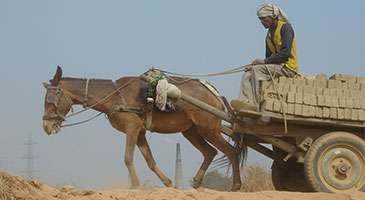New research could help the welfare of working animals

With over 42 million horses and 95 per cent of the world's donkeys found in developing countries, new research could change the health and welfare of millions of working animals in some of the poorest parts of the world.
The three research studies led by Dr Becky Whay, Reader in Animal Welfare and Behaviour in the School of Veterinary Sciences at the University of Bristol, aim to build greater understanding and encourage collaboration in addressing the welfare problems of the world's working equids. The papers, funded by the Brooke, are part of a new collection of free research articles published online by the Equine Veterinary Journal (EVJ) and sponsored by World Horse Welfare.
The first paper, "The range and prevalence of clinical signs and conformation associated with lameness in working draught donkeys in Pakistan," aimed to identify lameness in all severities in the working donkeys examined, the related clinical signs and affected bone and muscle structures. The researchers found a high frequency of severe lameness, pain and foot, joint, tendon and spinal abnormalities in the working donkeys. The results from the study will enable future studies to identify risk factors for lameness in working donkeys and develop and monitor interventions aimed at reducing lameness incidence and severity.
The second paper, "Identifying behavioural differences in working donkeys in response to analgesic administration," looked at pain-related behaviour in working donkeys to enable their owners and vets to recognise and manage pain. The research found working donkeys receiving the non-steroidal anti-inflammatory drug (NSAID) meloxicam were more active and alert compared to their pre-treatment behaviour confirming the potential importance of NSAIDs in identifying and relieving pain related behaviour in working donkeys.
The final paper, "The range and prevalence of pathological abnormalities associated with lameness in working horses from developing countries," aimed to describe the range and frequency of medical abnormalities associated with lameness in working draught horses. The researchers found there was a very high incidence of multilimb lameness and its link with pain was of great concern. The team's findings should help identify risk factors and put in place treatment to reduce the prevalence of lameness in working equids.
Dr Becky Whay, speaking about the research, said: "Working horses and donkeys support the livelihoods of some of the world's poorest people. However, these animals are often overburdened and used for long hours in harsh conditions.
"We hope our research will make a difference to the lives of these animals and our work will advise owners and vets on how to better look after their animals."
Melissa Upjohn, Research Coordinator for the Brooke, added: "More research into the problems affecting working horses, donkeys and mules is vitally needed in order to improve the welfare of the animals that support the livelihoods of millions of people across the world. This collection enables us to share some of the evidence base which underpins our programmes."
In July this year more than 150 representatives from 27 countries attended the 7th International Colloquium on Working Equids to discuss the plight of the estimated 100 million working horses, donkeys and mules who sustain human livelihoods around the world. Dr Becky Whay from the University of Bristol was a member of the scientific committee for the colloquium. A key outcome of the event was the recommendation that broader access to research would encourage greater worldwide collaboration.
More information: 'The range and prevalence of pathological abnormalities associated with lameness in working horses from developing countries' by C E Broster, C C Burn, A R S Barr, H R Whay in Equine Veterinary Journal. www.ncbi.nlm.nih.gov/pubmed/19642408
'The range and prevalence of clinical signs and conformation associated with lameness in working draught donkeys in Pakistan' by C E Reix, C C Burn (nèe Broster), J C Pritchard, A R S Barr, H R Whay HR in Equine Veterinary Journal. DOI: 10.1111/evj.12231
'Identifying behavioural differences in working donkeys in response to analgesic administration' by F H Regan (nèe Ashley), J Hockenhull, J C Prichard, A E Waterman-Pearson, H R Whay in Equine Veterinary Journal. DOI: 10.1111/evj.12356
Provided by University of Bristol














